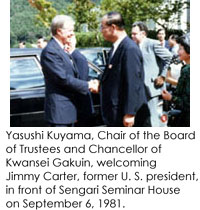- TOP
- About Kwansei Gakuin
- History and Educational Philosophy
- L' Esprit de Kwansei Gakuin(3)

L' Esprit de Kwansei Gakuin
L' Esprit de Kwansei Gakuin
> April 2009 -October 2011 > December 2011 -February 2016 > April 2016 -
Christmas Caroling
When the Christmas season comes, Kwansei Gakuin Glee Club goes caroling around the campus. At one time, the singers would visit the houses of the American and Canadian missionaries, who deeply appreciated their performance and remember their beautiful voices long after leaving Japan for their homelands.
David Woodsworth, the second son of H. F. Woodsworth, a Canadian missionary who served for years as the dean of the Literary College, noted that the Glee Club’s favorite song was “Joy to the World.” He recalled the students’ Japanese-inflected pronunciation of “the world” and that his father’s favorite, which he would sing each Christmas, was “Good King Wenceslas.”
Florence Metcalf, daughter of M. M. Whiting, a Canadian missionary who taught at the Middle School before the Second World War, wrote a book entitled Why Japan in 1912? In it she describes sweet memories of Christmas Eve: “There were ten mission homes all in a row, ours was #6. At first I could barely hear the singing in the distance. Gradually, as the group would go from house to house, the caroling would get louder and louder. At last they were at our house, and right outside my window! My room was on the second floor, so I could see them very well. Even though it was the middle of the night, I would jump out of bed and run to the window. They would wave to me and shout, ‘Merry Christmas, little Whiting girl.’ Then they would sing.” Florence also mentions that their pronunciation was idiosyncratic, but their beautiful harmonizing was divine.
The little girl would lie motionless in bed and listen very carefully until the last voices disappeared into the still, cold night.
Yuko Ikeda, Kwansei Gakuin Archives(December 2011)
[Special thanks to Camilla Blakeley for editorial assistance in English.]
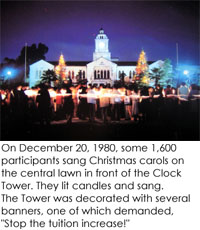
Prof. Shigeru Nakajima and the Official Repudiation of the Emperor Organ Theory
On December 20, 2006, an interesting discovery at the Library of Congress in Washington, DC, was reported in the Kobe Shimbun newspaper. A confidential document was unearthed entitled “Investigation of each university’s theory on Japanese Constitutional Law.” It had been commissioned in 1935 by Mombusho, the Japanese Ministry of Education, and requisitioned by the American GHQ in Japan after the Second World War.
The paper is a study of the level of support for the emperor organ theory among Japanese constitutional scholars. The controversial theory held that the emperor was merely an organ of state, as defined through the constitutional structure, rather than a sacred figure who stood above it. Nineteen scholars were divided into three groups according to the depth of their support for the concept. Prof. Shigeru Nakajima of Kwansei Gakuin University was regarded as one of the most dangerous adherents to this liberal constitutional interpretation, along with Shinobu Tabata, from Doshisha University, Toshiyoshi Miyazawa, from Tokyo Imperial University, and other five scholars. They were to be dealt with immediately.
The document reveals how severely the state pursued Nakajima. In early April, he declared to a public prosecutor, “I am an emperor organ theorist. I will have great satisfaction in giving my life for the theory.” One month later, he had shifted his position: “On reflection, I have decided not to teach the emperor organ theory. It does not mean I have changed my opinion.”
One of his students wrote in 1979, “I still remember distinctly the sharp, piercing eyes of Prof. Nakajima, who was in poor health and had a thin body. He said to us that Hitler’s Nazism would be soon defeated by historical judgment.” This alumnus also mentioned that it had been whispered that the Special Political Police from the Nishinomiya Police Station were trying to obtain a notebook from Nakajima’s class.
The Ministry of Education did not give up putting pressure on Nakajima and Kwansei Gakuin. On October 12, 1935, C. J. L. Bates, President of Kwansei Gakuin University, was summoned. He wrote in his diary, “Yesterday went to Mombusho. Saw Mr. Akama. Had full talk with him about Prof. Nakajima and the teaching of the Constitution. He says that is no longer sufficient not to teach the Kikan Setsu [the emperor organ theory] but that the teacher of Constitutional Law must teach that Shuken no Shutaiwa Tenno de aru [Sovereignty rests with the emperor].” Three days later, a government statement to clarify the national principle of imperial sovereignty was declared and the emperor organ theory was eliminated.
Yuko Ikeda, Kwansei Gakuin Archives (October 2011)
[Special thanks to Camilla Blakeley for editorial assistance.]
【 Click to enlarge. 】

The Neglected Grave, Aoyama Cemetery, Tokyo
“I was pained to hear this morning of the death of your dear little babe … You have been passing through deep waters. We knew it, though we did not realize how deep; but we have been praying for you daily, and many times a day bearing you up in prayer.” W. R. Lambuth wrote this letter of September 17, 1888, to J. C. C. Newton and his wife, Lettie, on the loss of their daughter. It had been less than four months since they arrived in Japan, and Annie Grace Newton was just one year old.
Newton, later the first dean of the Biblical Department and the third president of Kwansei Gakuin, and his wife reached Yokohama on May 21, 1888, with two daughters, Ruth and Annie. He had been appointed to the Philander Smith Biblical Institute, Tokyo, which was run cooperatively by the Methodist Episcopal and the Canadian Methodist missions. The Southern Methodist Church was to join this management. Two months after their arrival, Newton visited Kobe and wrote to his wife, “I have never seen men more zealous than the Drs. Lambuth. They are unceasing in their labors by day and night.”
Annie was buried in Aoyama Cemetery in Tokyo. Thirty-five years later, Newton and his wife finished their work in Japan and left for the United States. In Atlanta, Lettie passed away in 1928 and her husband in 1931. People who knew where the Newtons’ little daughter lay in Japan were also gone within a few years.
One hundred years after Annie’s death, John Krummel of Aoyama Gakuin was researching the cemetery. He found the neglected grave and contacted Kwansei Gakuin. We restored it, but to our regret, insufficient inquiries were made and the year of Annie’s death was engraved incorrectly as 1889.
Yuko Ikeda, Kwansei Gakuin Archives (August 2011)
[Special thanks to Camilla Blakeley for editorial assistance.]
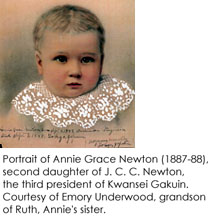
Father Bates and His Daughter, Lulu
For C. J. L. Bates, the fourth president of Kwansei Gakuin, Lulu, his only daughter of four children, became his emotional mainstay as his wife suffered from a chronic illness. She was living in Toronto while her parents were in Japan, so Bates had to depend on correspondence. On March 19, 1937, a letter from Lulu taught him that she had fallen deeply in love with a French Swiss named Claude de Mestral. The thirty-three-year-old was a graduate student at Emmanuel College. Bates wrote his innermost feelings in his diary the following day: “If Claude de Mestral – sounds like a troubadour, he ought to wear doublet and hose – has won Lulu’s love, he has gained the most precious thing that earth has to give. He will need to be a very good man to be worthy of it.”
At the end of that month, Bates received a letter from de Mestral telling of his love for Lulu and asking for the blessing of her parents. It was a fine letter and Bates had to consider him to be a good man indeed.
On June 18, Bates received a cable from Toronto saying, “Daughter of Bates to be married June 29.” Being so far away, he was unable to return to see his dearest daughter in her bridal dress and to give her away at the wedding. Instead, he again expressed his honest feelings as a father in his diary: “So my dear Lulu whom I have loved so dearly and so tenderly since I carried her [from] the hospital thirty one years and a half ago as an infant babe, is going to leave us and go with a man whom she met only six months ago, and she will take his name, and keep his house, and make his home, and bear his children …”
Four years later, Lulu gave birth to a baby boy. Armand was the third grandchild for the Bateses. When Armand de Mestral was given an honorary doctorate from Kwansei Gakuin University in 2001, he made a distinguished figure in his grandfather’s academic gown.
Yuko Ikeda, Kwansei Gakuin Archives (June 2011)
[Special thanks to Camilla Blakeley for editorial assistance.]
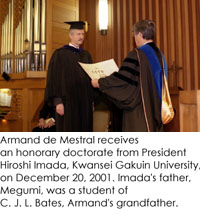
Two Bits from Henry Isenbourg
The Branch Memorial Chapel, now being used as the Kobe City Museum of Literature, is a symbol of the early days of Kwansei Gakuin in Harada-no-mori. This chapel is named after John Branch, a banker from Richmond, Virginia, who paid most of its building expenses. His father, Thomas, had been a great financial help in the founding of Kwansei Gakuin. When an independent chapel became necessary for the institution, S. H. Wainright, the dean of the Academic School, and W. R. Lambuth, the founder, asked his son for the additional funds.
Others helped to build the house of worship, too. The brand new chapel was dedicated on October 24, 1904, and Wainright referred to “the American friends who would never see the chapel, and who had never visited the land in which it stands, [but] had helped to build [it].”
There is a heartwarming story about a boy who was part of that effort. While fundraising for the chapel, Wainright had visited a church in Monticello, Missouri, and asked for donations. At first, there was no response, but then an eight- or nine-year-old boy stood up and gave him fifty cents that he had earned by selling evening papers. This boy’s name was Henry Isenbourg. Fifty cents was a lot of money for young Henry. His generosity deeply impressed the congregation, which then dug deep into its own pockets.
Sadly, several years later, after Henry had graduated from university and got a job in a bank, he lost his life on the Mississippi River. He helped other passengers and shared the fate of an old ship that was foundering.
In February 1957, Kozo Nishio, a teacher from Kwansei Gakuin Senior High School, was studying at a university in Missouri. There he found Henry Isenbourg’s father, who was living in New London. The father kindly showed Nishio the church where Henry had offered his two bits to Kwansei Gakuin, the elementary school where he had studied, and the Mississippi River, where he had been mercilessly taken.
Yuko Ikeda, Kwansei Gakuin Archives (February 2011)
[Special thanks to Camilla Blakeley for editorial assistance.]
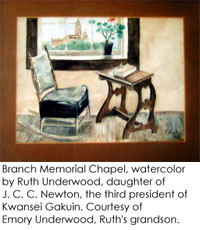
Old Friends for Thirty Years, Bates and Matthews
C. J. L. Bates, a missionary from the Canadian Methodist Church based in Japan, was staying in Karuizawa in the summer of 1908. One Afternoon, W. K. Matthews, a missionary from the Methodist Episcopal Church, South, United States, paid a visit to talk about the possibility of the Canadian Methodist Mission joining in the work of Kwansei Gakuin. It was the first time Bates had heard of Kwansei Gakuin. At that time the Canadians did nothing further as they were considering the possibility of reopening a middle school in cooperation with the Theological School of Aoyama Gakuin. After nearly ten years, the Japanese government was easing up on restrictions to religious education, allowing the Canadian missionaries to re-enter the field.
Matthews, the older man by six years, had come to Japan in 1902, at almost the same time as Bates. After two years’ work in Yamaguchi, Matthews joined the staff at Kwansei Gakuin and became the librarian there in the spring of 1908. He is known for having converted Kwansei Gakuin Library to the use of Dewey Decimal Classification system. In his later years, he wrote that this system was being used only in the public library in Yamaguchi City at that time.
The Canadian Board of Missions eventually decided to unite with the Southern and Japan Methodist Churches in education work at Kwansei Gakuin. In September 1910, just a hundred years ago, Bates, his wife, and their two children arrived at Harada-no-mori, the old site of Kwansei Gakuin, and were welcomed by T. H. Haden and his wife. Matthews was in the United States on furlough.
Bates served as the fourth president of Kwansei Gakuin for twenty years. Sadly, at the graduation ceremony in March 1939, where he was making a speech to the graduating class, some people took issue with his role as president in the brief that the school should have a Japanese person in that position. The criticism cast Kwansei Gakuin into a state of confusion, and Bates was deeply hurt by the episode. He decided to resign his presidency, as it was indeed a difficult time to be a non-Japanese president at a Japanese school.
His last day finally came. He was to leave Kobe for Canada by ship on December 30, 1940. When Bates finished his last supper with his wife on December 29, Prof. and Mrs. Matthews came in for the last chat. Matthews had been “a dear friend for thirty years” for Bates. The two men may well have sat near the fire talking of their summer meeting in Karuizawa 32 years earlier.
Yuko Ikeda, Kwansei Gakuin Archives (December 2010)
[Special thanks to Camilla Blakeley for editorial assistance.]
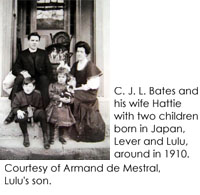
“Launch out into the deep.” (Luke 5:4)
In 1889 Kwansei Gakuin started with two schools, Biblical and Academic. In 1912 the College Department, Literary and Commercial, was founded. And finally, in 1932, the university was established. C. J. L. Bates, the fourth president of Kwansei Gakuin and its first university president simultaneously, thought that establishing a university in a mission school was a great step in its development, and he published his thoughts in December 1932 in the Kwansei Gakuin Shimbun (Kwansei Gakuin News) in an article entitled “The Mission of K. G. University.”
Bates pointed out that Kwansei Gakuin remained a mission school in two senses. In the traditional sense it is one because it was founded by a missionary institution; in another sense, it is a school with a mission. It is not enough to make our university simply an institution of learning. It must be a centre of education in the deepest meaning of the term.
The English word education comes from two Latin words: e or ex which means “out of,” and duco which means “to lead.” Education, in this sense, means to lead out the natural qualities in the student to stimulate independent thought and expression, and to develop initiative, self-reliance, and self-control, not simply to train the student in modes of efficiency. Education is usually translated into a Japanese word, kyoiku, which has a different origin. It comes from two Chinese words: kyo, which means “junior learns from that senior shows,” and iku, which means “to lead to practice good things.” The Japanese word manabu comes from maneru, which means ”to imitate.” It is usually used as a translation of to learn or to study.
So we must look to Bates’s original words, rather than translating them, if we want to follow the mission that he explained some seventy-eight years ago.
Bates also wrote, “Our Mission is to make men, men of pure hearts, men of strength of character, men of quickened insight, men of fidelity to truth and duty, men of sincere loyalty and unswerving faithfulness, men of magnanimity.” He particularly emphasized the concept of magnanimity, which he interpreted as greatness of soul.
When he felt prepared to take the next step in the development of Kwansei Gakuin, he showed this affirmation of mission to the members of the Kwansei Gakuin community and declared, “Launch out into the deep.”
Yuko Ikeda, Kwansei Gakuin Archives (October 2010)
[Special thanks to Camilla Blakeley for editorial assistance.]

A Good Dinner, July 6, 1912
The College Department (Literary and Commercial) of Kwansei Gakuin was founded in 1912. The establishment of the department was rocky. It had just fifty applicants for its quota of 100 students. Only the oral examination was held, and thirty-nine applicants were given places: three literary and thirty-six commercial. The building for the College had not yet been constructed and it had neither enough teaching staff nor enough books.
C. J. L. Bates, the first dean, told the students, “Be patient.” He also encouraged them, saying, “Be ambitious,” and “You must have a vision.” He often showed his leadership, citing the Bible, “I was not disobedient unto the heavenly vision,” (Acts 26:19) and “Where there is no vision, the people perish” (Proverbs 29:18).
Yet the students were ready to give vent to their frustration just before the first summer holidays. They insisted that exams be postponed because they could not study under such poor conditions. Several were seriously looking for better schools. Then each student and teacher received an invitation from Dean Bates.
At noon on July 6, 1912, in one room of the Divinity Hall, they had a wonderful dinner in a most friendly atmosphere. The menu was soup, boiled perch with white sauce, veal patties, fricassee of chicken, rice curry, ice cream, fruit, and coffee. One student who had been planning to transfer to another school, changed his mind and wrote a letter to Dean Bates: “I have decided to remain here because this warmth cannot be offered by any other school than Kwansei Gakuin.” This “good dinner tale” was passed down from generation to generation.
Yuko Ikeda, Kwansei Gakuin Archives (August 2010)
[Special thanks to Camilla Blakeley for editorial assistance.]
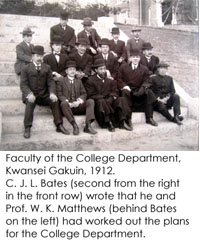
Canada and Kwansei Gakuin, Japan
It was in 1910, just 100 years ago that Canadian Methodist Church joined the management of Kwansei Gakuin, which had been founded in 1889 by the Methodist Episcopal Church, South, United States. Almost two decades later, Japan opened a legation in Ottawa in 1928, and the following year Canada established a mission in Tokyo. Kwansei Gakuin’s partnership with Canada thus dates back further than diplomatic relations between the two nations.
The Hon. Herbert Marler, the first Canadian envoy to Japan, arrived in September 1929. By the end of November, he had already visited Kwansei Gakuin. According to Kwansei Gakuin Shimbun (Kwansei Gakuin News), he was introduced to the student body by President C. J. L. Bates and gave a major international lecture in the central auditorium.
There followed a terrible period between the two countries. Canada declared war against Germany on September 10, 1939, entering the war on the opposite side to Japan. One Canadian member of parliament, J. S. Woodsworth, stood isolated in the Green Chamber and defended in emotional terms his lifelong belief that war – any war – was wrong.
Even members of the party he had helped to found, the Co-operative Commonwealth Federation, did not support him. J. S. Woodsworth was the brother of H. F. Woodsworth, the dean of the Literary College, Kwansei Gakuin.
After the war, C. J. L. Bates was himself asked by the Canadian government to become Ambassador to Japan, though he did not accept the post. Mitsukame Kawabe, one of his students and the first principal of Kwansei Gakuin Senior High School, related this incident. Kawabe noted that the key aspects of Bates’s personality were magnanimity, respect for character, harmony, and cooperation.
We also cannot forget about the Norman brothers, whose father, Daniel, was a trustee of Kwansei Gakuin for years. Howard Norman became a missionary and taught at the School of Theology, Kwansei Gakuin University. Herbert Norman, born and raised in Japan, became a very well-known diplomat and also a respected scholar of Japanese history. He met a tragic end in Cairo in 1957. In response, reporters came to Kwansei Gakuin to learn more about him.
In 1961, John G. Diefenbaker, Prime Minister of Canada, visited Japan as a state guest, and paid a visit to Kwansei Gakuin. It can be seen that Kwansei Gakuin has played host to many distinguished Canadians.
Yuko Ikeda, Kwansei Gakuin Archives (June 2010)
[Special thanks to Camilla Blakeley for editorial assistance.]
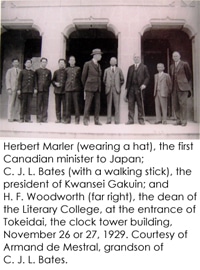
J. C. C. Newton, Fosterer of Kwansei Gakuin, Japan
After founder W. R. Lambuth left Kwansei Gakuin at the end of 1890, J. C. C. Newton, the first dean of the Biblical School, remained at the institution to impart the founder’s spirit and build a firm foundation, and eventually to become the third president. Newton’s students admired the foster father more than they had the true father. He called them “Brother,” in a warm tone. By contrast, C. J. L. Bates, the fourth president, addressed the students formally as “Gentlemen.” Let me paint a picture of J. C. C. Newton.
On a streetcar ride from Motomachi to Kamitsutui, where Kwansei Gakuin was located, a student gave his seat to an old lady. Newton was in the same car. Seeing the young man’s kind action, he presented himself to the lady and began to explain in poor Japanese, “This is a student at Kwansei Gakuin.” This embarrassed the student and he tried to make his escape, but Newton held his hand firmly. The warmth and softness of Newton’s friendly grip were deeply engraved on this student’s mind.
“All present!” Newton would say joyously each time he took the roll call, even if two-thirds of the class was absent. It was said that Newton’s evaluation depended on how many times a student had written the word “God” in his examination paper.
When officers from the Students’ Union claimed that Newton was too old to be president, he asked them to help such an old president as he by praying with him and supporting him until the next one could be elected.
The more mischief students raised, the more kindness Newton would show them. He never scolded them for not attending the chapel, and he paid individual attention to each student – even though he was so absent-minded that he could never find his own umbrella among others in an umbrella stand. In the face of such kindness, even the Middle School students, who were at the most mischievous age, would reflect on their misdemeanours and try to be better behaved.
Yuko Ikeda, Kwansei Gakuin Archives (April 2010)
[Special thanks to Camilla Blakeley for editorial assistance.]
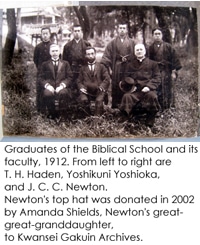
Small Cross on the Gravestone of J. W. Lambuth
When I visited the foreign cemetery at Shiogahara, Kobe, four years ago, I found a small silver cross on the gravestone of J. W. Lambuth. Lambuth was a missionary of the Methodist Episcopal Church, South, in the United States, the husband of M. I. Lambuth, and the father of W. R. Lambuth, the founder of Kwansei Gakuin.
The cross was in exactly the same style as one I had been given by John South Lewis when I visited the Lambuth family’s home state, Mississippi, in the summer of 2004. John is one of the descendants of J. W. Lambuth’s brother, a circuit minister in Mississippi, who supported his brother’s missionary work in China financially. Giving me the cross, John said, “This is small enough to be always with you. No one notices it.” He would quietly touch his own cross in his pocket when he needed to calm himself.
Why was the cross here, in the peaceful cemetery? More than a year had already passed since John had visited the cemetery. At that time, he had buried his cross near J. W. Lambuth. Now, it was shining in front of my eyes as if it had been waiting for my visit.
I told Ryohei Taniguchi, who had accompanied me to the cemetery, about this mysterious discovery. To my surprise, he explained that he had placed the cross on the tombstone himself. He went to the cemetery every weekend to conduct research on the epitaphs. One day he had happened to find a small cross near the gravestone of J. W. Lambuth and had placed it on the stone. Since then, he had always checked on the cross during his visits.
An employee of the Office of the Kobe Foreign Cemetery heard this story and kindly buried the cross again. He said to me on the phone, “I dug a deep hole for the cross. So it can be always with J. W. Lambuth even if there is a heavy rain or a strong wind.”
Yuko Ikeda, Kwansei Gakuin Archives (February 2010)
[Special thanks to Camilla Blakeley for editorial assistance.]
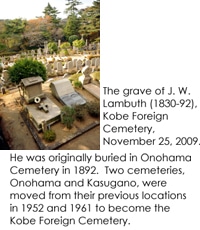
The First Decorated Christmas Tree
When the Christmas season comes, a pair of Himalayan cedar trees in front of the University Library Old Building at the Uegahara-Nishinomiya Campus of Kwansei Gakuin is illuminated and the building itself is lit up as well. This custom is familiar with neighbours of the campus, too, as the poetic event of winter.
It was on November 28, 1994, just seven weeks before the terrible earthquake, that the first Advent lighting service was held. In the darkness after the sun went down at six o’clock in the evening, hand bell music was performed and hymns were sung by the university choir. Some 700 participants, including students and neighbours, gathered with candles in hand on the central lawn.
When did this tradition of illumination begin at Kwansei Gakuin? W. D. Bray, an American Methodist missionary who had served as a professor in the School of Theology, said in his last lecture on October 27, 1980, “The big trees in front of the Library (Old Building) were cut down during the campus strife. Six years before that, we began to decorate them with red and yellow lights. It was my idea. It cost just 20,000 yen.”
Looking farther afield, when and where was the first tree decorated? I would like to assert that it was in Riga, the capital city of the Republic of Latvia, though there may be different stories. According to a Japanese brochure published by the Riga City Council Foreign Affairs Office, merchants in Riga decorated a fir tree with flowers for the first time in 1510 to celebrate the birth of Christ. We had a Latvian teacher named Ian Ozolin at Kwansei Gakuin 90 years ago, and he also began to work in Kobe as a consul for his country, which had been just founded.
Yuko Ikeda, Kwansei Gakuin Archives (December 2009)
[Special thanks to the Latvian Embassy in Tokyo for the photo and Camilla Blakeley for editorial assistance.]
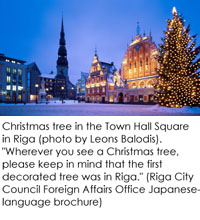
Seneca Romoff, Matsuyama, Japan
One month after the Russo–Japanese war broke out, a prison camp was established in Matsuyama, Japan. Matsuyama was one of the mission stations of the Methodist Episcopal Church, South, United States, which had established Kwansei Gakuin in 1889. It is said that many Russian soldiers surrendered to the Japanese with the word “Matsuyama,” because the camp had gained a reputation for treating them very well.
A total of 6,000 or more prisoners were sent to Matsuyama, which had a population of 30,000. A very few had children with them. The record indicates that there were three children in Hamadera, and one child each in Shizuoka, Himeji, and Matsuyama.
At that time T. W. B. Demaree, who had taught at Kwansei Gakuin several years earlier, was in Matsuyama. He was asked to foster an eight-year-old Russian boy named Seneca. His father was Captain Romoff, who had been taken prisoner at Port Arthur. His mother seems to have been dead already. Language proved not to be an obstacle for the Russian boy and the Demaree children. When Seneca was “shot” in a war game, he would fall so realistically and lie so still that the Demaree boys knew he must have seen much actual action on the battlefield.
The last day of Seneca’s stay came suddenly. When his father came for him, Seneca was hiding in the pantry. The Demaree children found him and brought him to his father, who gave him a command. Seneca ran to Mrs. Demaree and threw his arms around her. There were tears in everyone’s eyes. However, as soon as his father issued another command, Seneca marched away behind him. No information was received about the father and son thereafter.
Yuko Ikeda, Kwansei Gakuin Archives (October 2009)
[Special thanks to Camilla Blakeley for editorial assistance.]
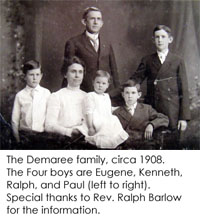
The Lambuths in Kobe, 1889
Kwansei Gakuin was founded in Kobe by Walter R. Lambuth in 1889, some 120 years ago. Walter was an American missionary of the Methodist Episcopal Church, South. The Lambuths had nine family members in Kobe: Walter and his wife, Daisy, and their two children; sister Nora; brother Robert and his wife, Alice; and their parents, William and Mary.
Nora Park had been serving as a missionary wife in China. Her husband was a doctor and Walter’s close friend. She came to Kobe to stay with her parents while she was pregnant. Robert came to Japan with his new bride, Alice, to teach English in Tokushima and Kobe. In 1889, three babies were born to these three couples. Nora and Robert were each blessed with a baby girl, and Walter had a baby boy. Their home, Yama Niban-kan, was full of happiness. At this time, as well, Robert established the Kobe Institute and Walter founded Kwansei Gakuin.
The next year a dark shadow began to creep over this happy family. Cholera spread widely through Kobe in 1890. First Robert’s family and then Walter’s left Japan because Alice and Daisy were in poor health. Robert settled down in Atlanta, prepared a house, and waited for his parents to return. But William died of an illness in Kobe and Alice became bedridden. Alice had lost both her parents as a girl, and the short and busy time she spent with her husband’s family in Kobe may have been the happiest of her life. Her illness worsened and with her last words, she entrusted her daughter to Mary.
That is the reason why only one of three Lambuth babies born in Kobe 120 years ago grew up there. Mary returned to Kobe with Alice’s child, Nettie, the daughter of her youngest son, Robert, and worked for Kobe Institute, which he had founded.
Yuko Ikeda, Kwansei Gakuin Archives (August 2009)
[Special thanks to Camilla Blakeley for editorial assistance.]
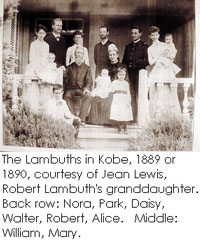
C. J. L. Bates in L’Orignal: An Excellent Preparation for His Life’s Work
Kwansei Gakuin was a small private institution founded in 1889 by the Methodist Episcopal Church, South, United States. In 1910, it began to be operated jointly with the Canadian Methodist Church, a move that enabled the school to develop but also caused constant conflict between the Southern Methodist group and the Canadian Methodist group. It was C. J. L. Bates, a Canadian missionary and the fourth president of Kwansei Gakuin (1920–40), who showed great leadership in solving these difficult problems.
Bates’s cooperative spirit and splendid ability to make the adjustments that the young institution needed seem to have been cultivated in his home village of L’Orignal, Ontario, where he was born and grew up.
L’Orignal was a small village, midway between Ottawa and Montreal, with a population of a thousand. Three-quarters of the inhabitants were French speaking. (That section of eastern Ontario had through the years become increasingly French speaking.) The village had one large French-speaking Roman Catholic Church and three small Protestant churches.
It was a frequent custom for the Bateses and their friends to attend the Presbyterian church on Sunday morning, Anglican vespers in the afternoon, and the Methodist church in the evening. Bates thought of these three churches as the house of prayer, the house of worship, and the house of praise. In his later years, he looked back on his experience of close acquaintance with three different churches as an excellent preparation for his life’s work.
Everyone in L’Orignal thought their own culture, language, and church the best, but a spirit of tolerance, goodwill, and mutual respect enabled them to solve their problems amicably. When the Methodist congregation was building its little church, it even received help from the Roman Catholic priest. Some of the women went to Father Berube for a contribution and he responded, “Oh, I can't give you anything to build a Protestant Church, but I can give you something to take down the old building on the lot.” And, with a hearty laugh, he handed them four dollars.
Yuko Ikeda, Kwansei Gakuin Archives (June 2009)
[Special thanks to Camilla Blakeley for editorial assistance.]

U. S. Presidents Associated with Kwansei Gakuin, Japan
As we all know, Barack Hussein Obama recently became the 44th president of the United States. His inauguration brought to mind American presidents associated with Kwansei Gakuin, Japan.
The first is Abraham Lincoln, the 16th president (1861–65). J. C. C. Newton, the third president of Kwansei Gakuin, had fought in the Civil War as a member of the Confederate Army. He kept a newspaper clipping with a portrait of Lincoln, hanging it in his room. Newton studied under Prof. H. B. Adams at the graduate school of Johns Hopkins University, and Woodrow Wilson, who later became the 28th president (1913–21), obtained his doctorate under the same professor. Kwansei Gakuin Archives possesses a small bust of President Wilson.
Incidentally, J. C. C. Newton was named after two presidential figures: John Caldwell Calhoun, vice-president of the 6th president, John Quincy Adams (1825–29); and Andrew Jackson, the 7th president (1829–37).
Grover Cleveland, the 22nd and the 24th president (1885–89 and 1893–97), was in the family tree of W. R. Lambuth, on his mother’s side. Lambuth was the founder of Kwansei Gakuin.
There is an interesting story with a Kwansei Gakuin connection regarding Charles Fairbanks, the vice-president of the 26th president, Theodore Roosevelt (1901–09). When Fairbanks came to Kobe in 1909, he expressed admiration for the refined English spoken by Yoshikuni Yoshioka, the second president of Kwansei Gakuin.
It is not very long since we received Jimmy Carter, the 39th president (1977–81), at Sengari Seminar House and held a Sunday service together. It was September 1981, just after the end of his presidency, and Carter was given an honorary doctorate by Kwansei Gakuin University. Sengari Seminar House closed in October 2005. Kwansei Gakuin was founded by the Methodist Episcopal Church, South.
Yuko Ikeda, Kwansei Gakuin Archives (April 2009)
[Special thanks to Camilla Blakeley for editorial assistance.]
